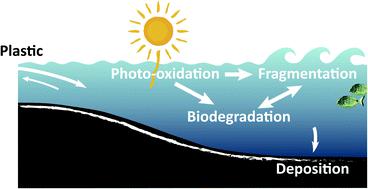当前位置:
X-MOL 学术
›
Environ. Sci.: Processes Impacts
›
论文详情
Our official English website, www.x-mol.net, welcomes your
feedback! (Note: you will need to create a separate account there.)
The fate of plastic in the ocean environment – a minireview
Environmental Science: Processes & Impacts ( IF 4.3 ) Pub Date : 2021-1-14 , DOI: 10.1039/d0em00446d Chloe Wayman 1, 2, 3, 4, 5 , Helge Niemann 5, 6, 7, 8, 9
Environmental Science: Processes & Impacts ( IF 4.3 ) Pub Date : 2021-1-14 , DOI: 10.1039/d0em00446d Chloe Wayman 1, 2, 3, 4, 5 , Helge Niemann 5, 6, 7, 8, 9
Affiliation

|
The presence of plastics in the marine environment poses a threat to ocean life and has received much scientific and public attention in recent years. Plastics were introduced to the market in the 1950s and since then, global production figures and ocean plastic littering have increased exponentially. Of the 359 million tonnes (Mt) produced in 2018, an estimated 14.5 Mt has entered the ocean. In particular smaller plastic particles can be ingested by marine biota causing hazardous effects. Plastic marine debris (PMD) is exposed to physical, chemical and biological stressors. These cause macro and microplastic to break down into smaller fragments, including sub micrometre sized nanoplastic particles, which may account for an important but so far unevaluated fraction of the ocean plastic budget. Physicochemical and biological deterioration of PMD also leads to the release of more volatile compounds and the terminal oxidation of PMD, which most likely accounts for an important but also unevaluated fraction in the ocean plastic budget. This minireview provides an overview on (1) the quantity of plastic production and waste, pathways for plastics to enter the marine realm, the inventory of PMD and the negative effects of PMD to ocean life. (2) We discuss plastic degradation mechanisms in the ocean, expanding on the processes of photodegradation and biodegradation. (3) This review also highlights the emerging topic of nanoplastics in the sea and provides an overview on their specific physical and chemical properties, potential harm to ocean life, and nanoplastic detection techniques.
中文翻译:

海洋环境中塑料的命运–回顾
海洋环境中塑料的存在对海洋生物构成威胁,并且近年来受到了许多科学和公众的关注。塑料是在1950年代引入市场的,此后,全球产量和海洋塑料垃圾成倍增加。在2018年生产的3.59亿吨(Mt)中,估计有14.5 Mt进入海洋。特别是较小的塑料颗粒可能会被海洋生物摄入,从而造成危险影响。塑料海洋垃圾(PMD)暴露于物理,化学和生物压力源。这些会导致宏观和微观塑料分解成较小的碎片,包括亚微米级的纳米塑料颗粒,这可能占海洋塑料预算的重要部分,但到目前为止尚未被评估。PMD的物理化学和生物降解还导致更多挥发性化合物的释放和PMD的最终氧化,这很可能是海洋塑料预算中重要但未评估的部分。这份小型审查提供了以下方面的概述:(1)塑料生产和废物的数量,塑料进入海洋领域的路径,PMD的库存以及PMD对海洋生物的负面影响。(2)我们讨论了海洋中的塑料降解机制,并扩展了光降解和生物降解的过程。(3)这篇综述还突出了海洋中纳米塑料的新兴话题,并对它们的特定物理和化学特性,对海洋生物的潜在危害以及纳米塑料检测技术进行了概述。
更新日期:2021-01-21
中文翻译:

海洋环境中塑料的命运–回顾
海洋环境中塑料的存在对海洋生物构成威胁,并且近年来受到了许多科学和公众的关注。塑料是在1950年代引入市场的,此后,全球产量和海洋塑料垃圾成倍增加。在2018年生产的3.59亿吨(Mt)中,估计有14.5 Mt进入海洋。特别是较小的塑料颗粒可能会被海洋生物摄入,从而造成危险影响。塑料海洋垃圾(PMD)暴露于物理,化学和生物压力源。这些会导致宏观和微观塑料分解成较小的碎片,包括亚微米级的纳米塑料颗粒,这可能占海洋塑料预算的重要部分,但到目前为止尚未被评估。PMD的物理化学和生物降解还导致更多挥发性化合物的释放和PMD的最终氧化,这很可能是海洋塑料预算中重要但未评估的部分。这份小型审查提供了以下方面的概述:(1)塑料生产和废物的数量,塑料进入海洋领域的路径,PMD的库存以及PMD对海洋生物的负面影响。(2)我们讨论了海洋中的塑料降解机制,并扩展了光降解和生物降解的过程。(3)这篇综述还突出了海洋中纳米塑料的新兴话题,并对它们的特定物理和化学特性,对海洋生物的潜在危害以及纳米塑料检测技术进行了概述。











































 京公网安备 11010802027423号
京公网安备 11010802027423号